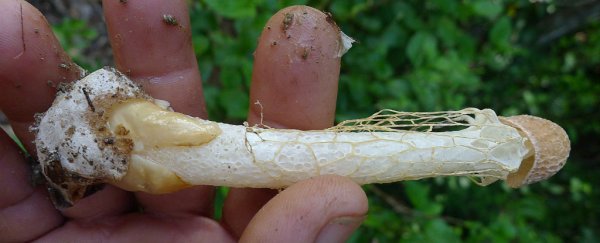An obscure, 15-year-old study has been getting a lot of attention lately thanks to a sensational claim made by a couple of scientists that an unnamed species of bright orange mushroom found in Hawaii caused spontaneous orgasms in a handful of women who smelt its odour.
But before you get too excited, we're sorry to tell you that there's no actual proof that this mysterious mushroom does anything of the sort, because all we're going off is a one-page observational study involving a very small sample size that's not yet been reproduced, and which makes some pretty dubious assumptions about female biology.
Let's start from the beginning. In 2001, a pair of medical scientists published a report in the International Journal of Medicinal Mushrooms (the site's down atm) describing the effects of an unnamed species of mushroom on 36 male and female volunteers.
Belonging to Dictyophora genus of stinkhorn mushrooms, which has since been renamed as Phallus, the mushroom is said to only grow on top of the 600 to 1,000-year-old lava flows of Hawaii, and the scientists, John C. Holliday and Noah Soule, describe it as particularly difficult to find.
Prompted by rumours that the mushroom's scent is a powerful female aphrodisiac, the pair conducted a 'smell test' on 16 female and 10 male volunteers. Six of the women reportedly experienced a mild (nope, not "earth-shattering"), spontaneous orgasm when they sniffed the mushroom, while the remaining 10 were found to have an increased heart rate when given a smaller dose.
The male volunteers, on the other hand, all said they thought the mushroom's "fetid odour" smelt disgusting, and that was the extent of its influence on them.
The researchers reported at the time:
"Indeed, nearly half of the female test subjects experienced spontaneous orgasms while smelling this mushroom. These results suggest that the hormone-like compounds present in the volatile portion of the spore mass may have some similarity to human neurotransmitters released during sexual encounters."
There are a bunch of problems with this claim, scientifically speaking. Firstly, 36 people is too small a sample size to prove much of anything, particularly as 20 of them reported feeling nothing but grossed out. Secondly, other than measuring an increase in heart rate - which on its own doesn't equal an orgasm - the scientists did little to prove that the self-reported orgasms actually happened.
Further, as we all know, the results of an experiment cannot be seen as definitive until they are reproduced under a different set of conditions, and this has yet to be attempted. There is also zero scientific evidence outside this study that an orgasm can be triggered solely by a scent, so if the researchers want to make that claim, they've got a whole lot of work to do.
A possible explanation could be that unidentified mushroom was actually the species Phallus indusiatus, or something very similar. Found in the tropical regions of southern Asia, Africa, the Americas, and Australia, this phallus-shaped stinkhorn mushroom is said to be a female aphrodisiac in Hawaiian and South Pacific lore, referred to as Mamalo o Wahine, which translates to "women's mushroom", and has a recorded history of use in Chinese medicine dating back to the 7th century AD.
Perhaps the women in the study were influenced by the mushroom's reputation. Perhaps its suggestive shape combined with the unnatural environment of a medical study conjured something in the minds of the six volunteers that wasn't entirely accurate. We'll probably never know, because the mushroom has never been identified, and until some definitive studies are published on the biology of scent-triggered orgasms, we're not going to hold our breath.
